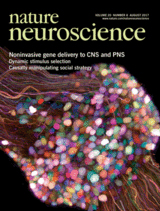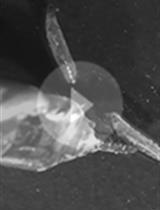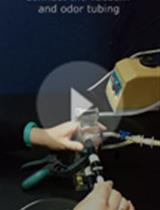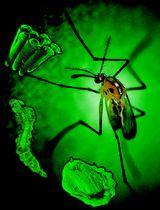- EN - English
- CN - 中文
Assaying Mechanonociceptive Behavior in Drosophila Larvae
果蝇幼虫机械伤害感受行为分析
发布: 2018年02月20日第8卷第4期 DOI: 10.21769/BioProtoc.2736 浏览次数: 9720
评审: Jay Z ParrishAnonymous reviewer(s)
Abstract
Drosophila melanogaster larvae have been extensively used as a model to study the molecular and cellular basis of nociception. The larval nociceptors, class IV dendritic arborization (C4da) neurons, line the body wall of the animal and respond to various stimuli including noxious heat and touch. Activation of C4da neurons results in a stereotyped escape behavior, characterized by a 360° rolling response along the body axis followed by locomotion speedup. The genetic accessibility of Drosophila has allowed the identification of mechanosensory channels and circuit elements required for nociceptive responses, making it a useful and straightforward readout to understand the cellular and molecular basis of nociceptive function and behavior. We have optimized the protocol to assay mechanonociceptive behavior in Drosophila larvae.
Keywords: Nociception (痛觉感受)Background
Nociception, the innate ability to detect and avoid noxious stimuli, is highly conserved across the animal kingdom. Drosophila melanogaster larvae are capable to detect and avoid a variety of noxious stimuli including noxious touch, heat and light (Tracey et al., 2003; Hwang et al., 2007; Xiang et al., 2010). Mechanical stimulation above a certain threshold (> 30 mN) elicits a stereotyped rolling escape response at all larval stages (Almeida-Carvalho et al., 2017), which is thought to have evolved to avoid ovipositor injection by parasitic wasps such as L. boulardi (Hwang et al., 2007). This escape response is mediated by activation of nociceptive C4da neurons, which possess sensory dendrites covering the entire body wall allowing the animal to detect noxious cues. C4da neurons express several mechanosensory channels belonging to the DEG/ENaC family (pickpocket [ppk], ppk26/balboa) (Zhong et al., 2010; Gorczyca et al., 2014; Guo et al., 2014; Mauthner et al., 2014), a mechanosensitive TrpA1 isoform (Zhong et al., 2012), piezo (Kim et al., 2012) and the Trp channel painless (Tracey et al., 2003), all of which are required for normal mechanonociceptive responses.
The escape response can be assayed by using a von Frey filament exerting a force between 30-120 mN, which activates mechanosensory channels in C4da neurons (Hwang et al., 2007; Kim et al., 2012). Recent work has also shed light on circuit mechanisms required for mechanonociceptive responses. Mechanically induced escape responses require co-activation of class II da (C2da) and class III da (C3da) sensory neurons, as silencing of either subset impaired rolling behavior (Hu et al., 2017). Moreover, this sensory integration is specific for mechanonociception and in addition requires neuropeptide-mediated feedback. We provide a detailed protocol from our recent work (Hu et al., 2017), which employed a mechanonociception assay based on previously described methods (Hwang et al., 2007; Caldwell and Tracey, 2010; Zhong et al., 2010). We typically use a mechanical force of 45-50 mN, which elicits weak responses after the first stimulus, but enhanced responses after a second subsequent stimulus. This approach allows assaying changes in sensitivity and sensitization of mechanonociceptive responses, which can be coupled with genetic approaches to identify molecular and network components required for normal escape behavior.
Materials and Reagents
- Drosophila vials (wide, K-Resin) (Dutscher, catalog number: 789002 )
- Flugs® fly plugs, plastic vials (wide) (Dutscher, catalog number: 789035 )
- Omniflex monofilament fishing line Shakespeare (6 lb test, diameter 0.23 mm) (Zebco, Tulsa, USA)
- Petri dishes (Ø 10 cm) (SARSTEDT, catalog number: 82.1473 )
- Fly stocks
Chromsome, Bloomginton stock center No.:
w1118 (X, BL 6326)
w*; ppk-Gal4 (X, 3rd, BL 32079)
w*;UAS-TNTE (X, 3rd, BL 28997)
w*; TrpA11 (X, 2nd , BL 36342) - Agar Kobe I (Carl Roth, catalog number: 5210.4 )
- Agar plates (see Recipes)
- Fly food (see Recipes)
- Agar (strings) (Gewürzmühle Brecht, Eggenstein, catalog number: 00262 )
- Corn flour (Davert, Newstartcenter, catalog number: 17080 )
- Soy flour (Davert, Newstartcenter, catalog number: 46985 )
- Brewer’s yeast (ground) (Gewürzmühle Brecht, Eggenstein, catalog number: 03462 )
- Malt syrup (MeisterMarken–Ulmer Spatz, Bingen am Rhein, catalog number: 728985 )
- Treacle (molasses) (Grafschafter Krautfabrik, Meckenheim, catalog number: 01939 )
- Nipagin (Methyl 4-hydroxybenzoate) (Sigma-Aldrich, catalog number: 54752-1KG-F )
- Propionic acid (Carl Roth , catalog number: 6026.3 )
- Agar (strings) (Gewürzmühle Brecht, Eggenstein, catalog number: 00262 )
Equipment
- Brush (Size 1, Boesner, model: Da Vinci Nova Serie 1570 , catalog number: D15701)
- Forceps (Dumont, #3) (Fine Science Tools, catalog number: 11231-30 )
- Light source (white light) LED Schott KL 1500 LCD (Pulch und Lorenz, catalog number: 150.200)
Manufacturer: SCHOTT, model: KL 1500 LCD . - SZX7 stereo microscope (Olympus, model: SZX7 )
Software
- Origin Pro 9.0 (OriginLab, Northampton, USA) or similar for statistical analysis
Procedure
文章信息
版权信息
© 2018 The Authors; exclusive licensee Bio-protocol LLC.
如何引用
Hoyer, N., Petersen, M., Tenedini, F. M. and Soba, P. (2018). Assaying Mechanonociceptive Behavior in Drosophila Larvae. Bio-protocol 8(4): e2736. DOI: 10.21769/BioProtoc.2736.
分类
神经科学 > 行为神经科学 > 感觉运动反应
神经科学 > 感觉和运动系统 > 动物模型
分子生物学 > DNA > 诱/突变
您对这篇实验方法有问题吗?
在此处发布您的问题,我们将邀请本文作者来回答。同时,我们会将您的问题发布到Bio-protocol Exchange,以便寻求社区成员的帮助。
提问指南
+ 问题描述
写下详细的问题描述,包括所有有助于他人回答您问题的信息(例如实验过程、条件和相关图像等)。
Share
Bluesky
X
Copy link














